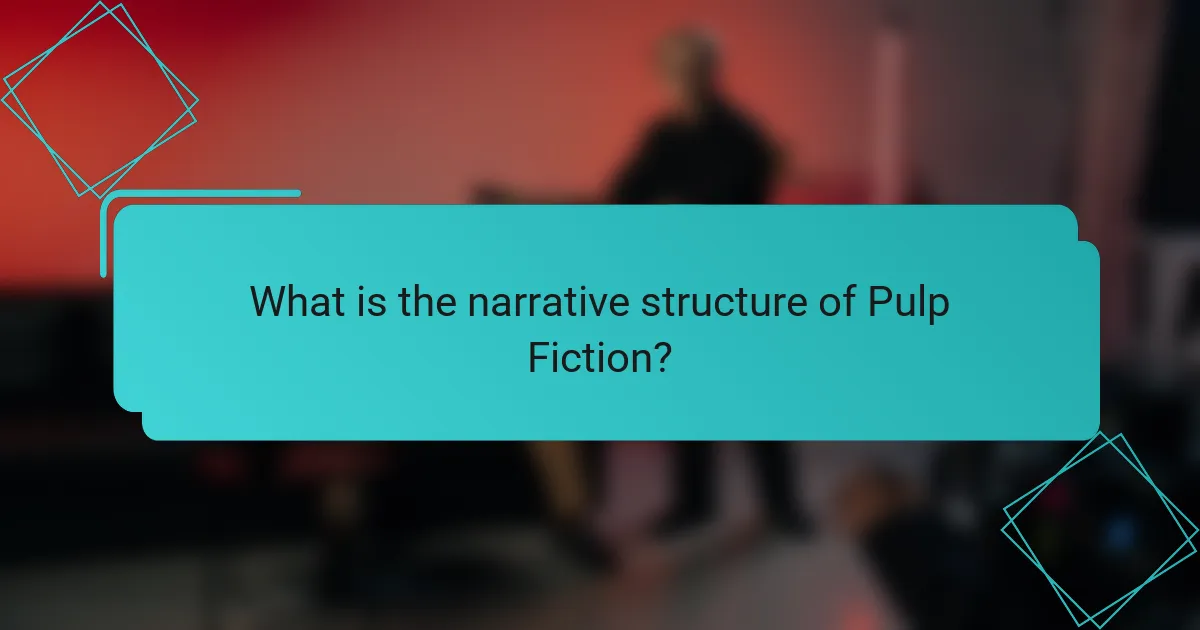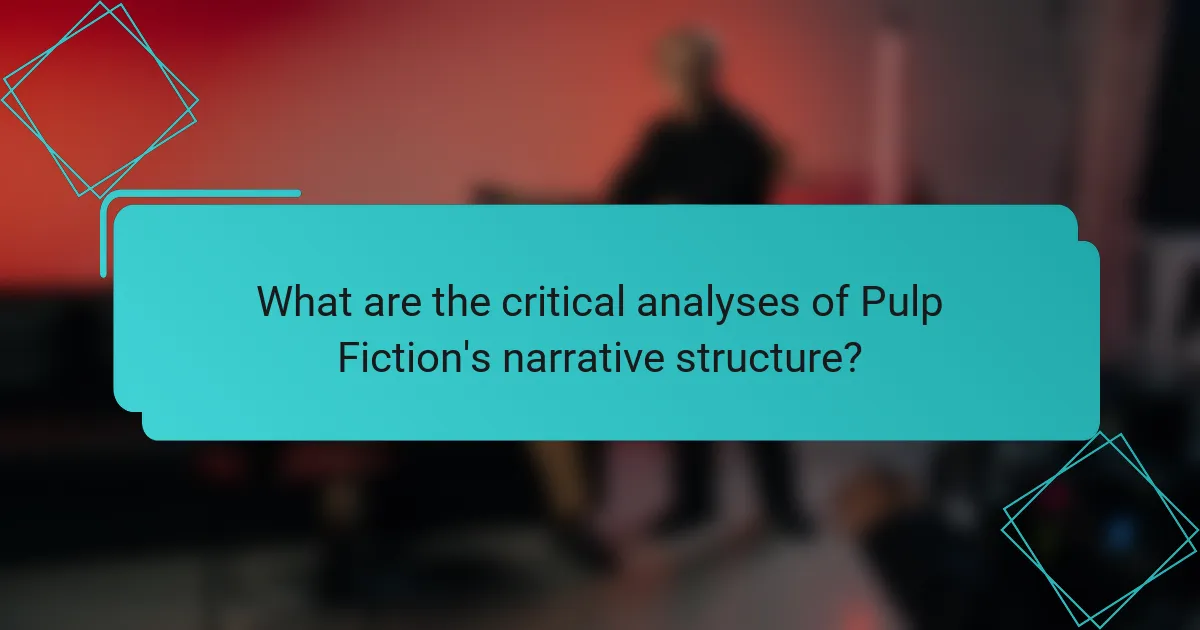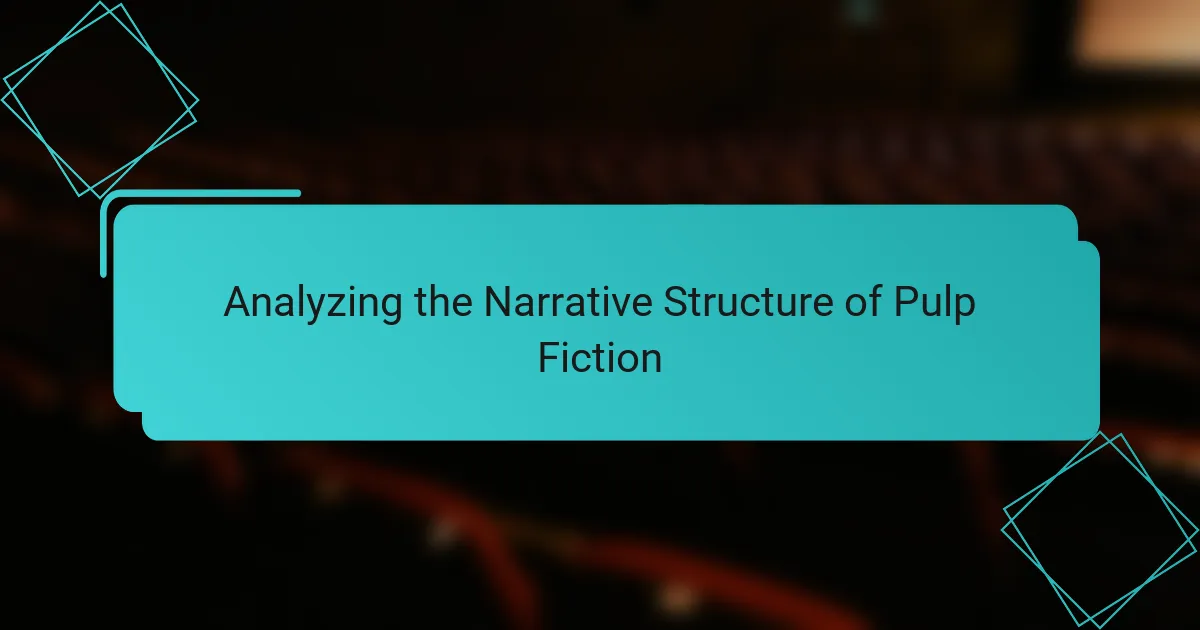The article analyzes the narrative structure of the film Pulp Fiction, directed by Quentin Tarantino. It highlights the film’s non-linear storytelling, which presents multiple interconnected stories out of chronological order, enhancing themes of fate and coincidence. The discussion covers how this fragmented timeline engages viewers and challenges traditional narrative forms, while also exploring character arcs and the significance of dialogue. Additionally, the article examines the use of cultural references and multiple perspectives, contributing to the film’s depth and complexity. The critical reception of this narrative style and its influence on postmodern storytelling methods in cinema are also addressed.

What is the narrative structure of Pulp Fiction?
The narrative structure of Pulp Fiction is non-linear. It presents multiple interconnected stories out of chronological order. The film consists of several segments that feature different characters and events. Each segment intersects with others, creating a complex tapestry of storytelling. Key scenes are revisited from different perspectives. This structure enhances themes of fate and coincidence. The use of this narrative style is a hallmark of Quentin Tarantino’s filmmaking. This approach engages the audience by challenging traditional storytelling conventions.
How does Pulp Fiction’s narrative differ from traditional storytelling?
Pulp Fiction’s narrative differs from traditional storytelling by employing a non-linear structure. The film presents its story out of chronological order. This technique creates suspense and engages the audience differently than linear narratives. Traditional storytelling typically follows a clear beginning, middle, and end. In contrast, Pulp Fiction intertwines multiple storylines that intersect at various points. Each segment can be viewed independently yet contributes to the overall narrative. This approach allows for deeper character exploration and thematic development. The film also uses dialogue-driven scenes that prioritize character interaction over plot progression. This is a departure from conventional narrative techniques that focus on action and plot advancement.
What are the key elements that define its unique narrative style?
Pulp Fiction’s unique narrative style is defined by non-linear storytelling, rich dialogue, and interwoven plots. The film employs a fragmented structure that dissects time and sequence. This approach creates suspense and engages viewers in piecing together the narrative. Additionally, character-driven dialogue reveals depth and personality. Each character’s distinct voice contributes to the film’s authenticity. The intertwining stories showcase themes of fate and coincidence. This narrative style has influenced numerous films since its release. Pulp Fiction’s innovative techniques have redefined modern cinema storytelling.
How does the non-linear timeline impact the viewer’s experience?
The non-linear timeline in “Pulp Fiction” enhances the viewer’s experience by creating suspense and engagement. This structure allows viewers to piece together the story from fragmented events. As scenes unfold out of chronological order, they invite active participation in the narrative. This approach challenges traditional storytelling methods and encourages deeper analysis. The disjointed timeline builds intrigue, making viewers question character motivations and outcomes. Research shows that non-linear narratives can lead to greater emotional investment from audiences. A study by David Bordwell in “Narration in the Fiction Film” highlights how such structures can amplify suspense and surprise. This complexity ultimately enriches the overall viewing experience.
Why is the narrative structure significant in Pulp Fiction?
The narrative structure of Pulp Fiction is significant because it employs a non-linear format that enhances storytelling. This structure allows multiple interconnected stories to unfold simultaneously. Characters are introduced in a way that blurs the lines between protagonist and antagonist. The disjointed timeline creates suspense and keeps viewers engaged. It also encourages viewers to piece together the narrative themselves. This method reflects themes of fate and chance prevalent in the film. The innovative structure has influenced many filmmakers since its release. Overall, it contributes to the film’s status as a cult classic.
What themes are emphasized through the narrative choices?
The themes emphasized through the narrative choices in “Pulp Fiction” include non-linear storytelling, the randomness of violence, and moral ambiguity. Non-linear storytelling showcases how events are interconnected yet presented out of chronological order. This structure enhances viewer engagement and reflects the chaos of the characters’ lives. The randomness of violence is portrayed through sudden, unexpected acts that challenge the notion of narrative predictability. This unpredictability reinforces the theme of fate versus free will. Additionally, moral ambiguity is evident in character decisions that blur the lines between right and wrong. Characters often face dilemmas that lack clear ethical answers, inviting audience reflection on morality. These narrative choices collectively deepen the exploration of complex themes in the film.
How do character arcs contribute to the overall narrative structure?
Character arcs significantly enhance the overall narrative structure by providing depth and progression to the story. They allow characters to evolve through experiences, impacting the plot’s trajectory. In “Pulp Fiction,” for instance, the arcs of characters like Vincent Vega and Jules Winnfield illustrate transformation. Their journeys reflect themes of redemption and moral ambiguity. As characters confront choices, the narrative tension escalates. This tension keeps audiences engaged and invested in outcomes. Character arcs also create emotional resonance, making the story more relatable. The interplay of these arcs intertwines with the non-linear storytelling, enriching the film’s complexity. Thus, character arcs are essential for a cohesive and compelling narrative.

What techniques does Tarantino use in Pulp Fiction’s narrative?
Tarantino employs non-linear storytelling in Pulp Fiction’s narrative. This technique presents events out of chronological order. It creates suspense and engages the audience. Characters’ arcs intersect in unexpected ways. Dialogue is another crucial technique; it is sharp and memorable. It serves to develop characters and advance the plot. Tarantino also uses cultural references throughout the film. These references enrich the narrative and provide context. Additionally, he incorporates multiple perspectives, allowing viewers to see events from different angles. This complexity enhances the film’s depth and intrigue.
How does dialogue shape the narrative flow in Pulp Fiction?
Dialogue in Pulp Fiction significantly shapes the narrative flow by creating tension and revealing character relationships. The film’s non-linear structure is complemented by dialogue that connects disparate scenes. Characters often engage in lengthy conversations that serve as both exposition and thematic exploration. For instance, the dialogue between Jules and Vincent reflects their philosophical views and moral dilemmas. This interaction establishes character depth while advancing the plot. Additionally, the use of pop culture references in dialogue adds layers to the narrative. These elements create a rhythm that guides the viewer through the film’s complex timeline. Overall, dialogue is essential in maintaining engagement and coherence in Pulp Fiction’s narrative.
What role does humor play in the storytelling process?
Humor enhances the storytelling process by engaging the audience and providing relief from tension. In narratives, humor can create memorable moments and deepen character development. It often serves to highlight absurdities within the plot or character interactions. In “Pulp Fiction,” humor is interwoven with violence and drama, creating a unique tone. For example, witty dialogue and unexpected comedic situations break the intensity of violent scenes. This juxtaposition keeps the audience invested and adds layers to the characters. Additionally, humor can facilitate emotional connection, allowing viewers to relate to characters in a more human way. Overall, humor plays a crucial role in balancing narrative elements and enriching the storytelling experience.
How do cultural references enhance the narrative structure?
Cultural references enhance the narrative structure by providing context and depth. They create connections between the story and the audience’s shared knowledge. This engagement fosters emotional resonance and relatability. In “Pulp Fiction,” Quentin Tarantino uses pop culture references to shape character identities. For example, the use of iconic songs and films reflects the characters’ personalities and motivations. These references also establish a specific time and place, grounding the narrative. Research indicates that cultural references can increase audience investment in the story. This technique allows for layered storytelling, enriching the overall narrative experience.
What is the significance of the film’s episodic format?
The film’s episodic format allows for a non-linear storytelling approach. This structure enables the exploration of multiple characters and storylines. Each episode functions as a self-contained narrative. This enhances viewer engagement by creating suspense and intrigue. The format emphasizes thematic connections between the episodes. It allows for deeper character development through varied perspectives. Additionally, this structure mirrors the unpredictability of life. Overall, the episodic format contributes to the film’s innovative narrative style.
How do the vignettes connect to create a cohesive story?
The vignettes in “Pulp Fiction” connect through shared characters and intersecting storylines. Each vignette features characters that reappear in different contexts. This creates a tapestry of interrelated events. The nonlinear narrative structure enhances the connections. Events unfold out of chronological order, revealing relationships gradually. For instance, Vincent and Jules’ story intersects with Mia’s and Butch’s narratives. The thematic elements of violence and redemption unify the vignettes. Additionally, recurring motifs, such as the briefcase, reinforce the narrative cohesion. These connections culminate in a multifaceted exploration of fate and choice within the film.
What impact does the episodic nature have on character development?
The episodic nature of a narrative significantly influences character development. It allows for distinct moments of growth or change to be showcased in isolated segments. Each episode can present a unique challenge or situation for characters. This structure enables viewers to see varied aspects of a character’s personality. For instance, characters may react differently to similar situations across episodes. This can highlight their complexities and inconsistencies. Additionally, the episodic format can create anticipation for character arcs. Viewers may become invested in how characters evolve over time. This investment can lead to deeper emotional connections. Overall, episodic narratives provide a framework for nuanced character exploration.

What are the critical analyses of Pulp Fiction’s narrative structure?
Pulp Fiction’s narrative structure is critically analyzed for its non-linear storytelling. The film employs a fragmented timeline, presenting events out of chronological order. This technique challenges traditional narrative forms and engages viewers in piecing together the story. Critics highlight how this structure enhances themes of fate and interconnectedness among characters. The use of vignettes allows for deep character exploration within brief segments. Additionally, the dialogue-driven scenes contribute to the film’s unique pacing and tone. Scholars note that this structure reflects postmodern storytelling methods, influencing subsequent films. The film’s narrative complexity has sparked extensive academic discussion and analysis.
What do film critics say about the effectiveness of the narrative?
Film critics generally praise the effectiveness of the narrative in “Pulp Fiction.” They highlight its non-linear structure as innovative. This approach creates suspense and engages viewers in unique ways. Critics note that the interwoven storylines enhance character development. The dialogue is often cited as sharp and memorable. Critics emphasize how the narrative challenges traditional storytelling. This complexity invites multiple interpretations and discussions. Overall, the narrative is seen as a defining element of the film’s success.
How has Pulp Fiction influenced modern filmmaking techniques?
Pulp Fiction has significantly influenced modern filmmaking techniques through its non-linear narrative structure. This film popularized the use of fragmented storytelling, allowing filmmakers to present events out of chronological order. It demonstrates how non-linear narratives can enhance character development and thematic depth. The film’s interwoven storylines create a complex tapestry that engages audiences. It also showcases the effective use of dialogue-driven scenes, emphasizing character interactions over traditional plot progression. Pulp Fiction’s stylistic choices, such as abrupt scene transitions and eclectic soundtracks, have become widely adopted. Many contemporary filmmakers cite it as a reference point for innovative storytelling. Its impact is evident in films that prioritize character-driven narratives and experimental structures.
What are common misconceptions about its narrative structure?
One common misconception about the narrative structure of Pulp Fiction is that it is entirely non-linear. While the film does employ a non-linear approach, it is structured around several interrelated stories. Each story has a clear beginning, middle, and end, even if they are presented out of chronological order. Another misconception is that the film lacks a cohesive plot. In reality, the narrative weaves together themes of fate, redemption, and violence, creating a cohesive experience. Additionally, some believe that the film’s structure is purely experimental. However, Quentin Tarantino uses this structure to enhance character development and thematic depth. These misconceptions overlook the film’s intentional design and narrative artistry.
How can viewers better appreciate the narrative structure of Pulp Fiction?
Viewers can better appreciate the narrative structure of Pulp Fiction by recognizing its non-linear storytelling. The film employs a fragmented timeline that interweaves multiple storylines. Each storyline is presented out of chronological order, challenging traditional narrative forms. This structure enhances thematic depth and character development. Viewers can focus on how events influence each other across the narrative. Understanding the connections between the stories reveals underlying motifs. The film’s unique approach encourages active engagement and interpretation. Analyzing character arcs within this framework deepens appreciation for the narrative complexity.
What tips can enhance the viewing experience of Pulp Fiction?
To enhance the viewing experience of Pulp Fiction, consider watching it in chronological order. This approach allows viewers to follow the story more linearly. It can help in understanding character development and plot progression. Another tip is to engage with the film’s dialogue. The witty and sharp exchanges are key to its charm. Paying attention to these interactions can reveal deeper themes. Additionally, using high-quality audio and visual equipment improves immersion. The film’s unique soundtrack complements its scenes effectively. Lastly, discussing the film with others after viewing can provide new insights. This collaborative analysis can deepen appreciation for its narrative structure.
How can understanding the narrative structure deepen one’s analysis of the film?
Understanding the narrative structure can enhance film analysis by revealing how story elements interconnect. In “Pulp Fiction,” the non-linear narrative challenges traditional storytelling. This structure allows for multiple perspectives and themes to emerge simultaneously. Analyzing these connections can uncover deeper meanings and character motivations. For instance, the juxtaposition of scenes creates tension and irony. This technique encourages viewers to engage actively with the film. By recognizing these narrative choices, one can appreciate the filmmakers’ artistic intentions. Such insights contribute to a more comprehensive understanding of the film’s impact and significance.
The main entity of the article is the narrative structure of the film “Pulp Fiction.” The article provides an in-depth analysis of its non-linear storytelling, highlighting how it presents multiple interconnected stories out of chronological order. Key elements discussed include the impact of this structure on viewer engagement, character development, and the exploration of themes such as fate and moral ambiguity. Additionally, the article examines Quentin Tarantino’s techniques, including dialogue and cultural references, that contribute to the film’s unique narrative style and its influence on modern filmmaking.
